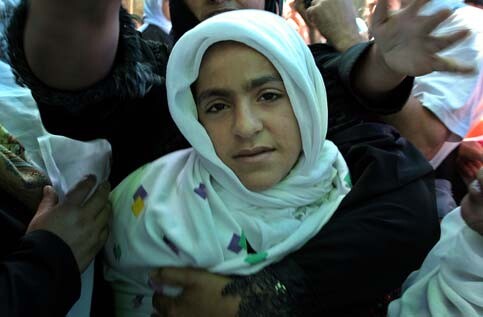The Electronic Intifada 11 June 2006

A Palestinian girl Huda Ghali weeps during the funeral of her family members killed yesterday in Israeli shelling of the northern Gaza Strip’s seafront, in the town of Beit Lahiya June 10, 2006. Palestinian officials said Israeli air strikes and artillery fire had killed 10 Palestinians, including three children and on a crowded Gaza beach, the highest Palestinian death toll in a single day since late 2004. (MaanImages/Wesam Saleh)
4 pm, Friday afternoon, 9th June:
Hoda, age 12, with her brothers and sisters, running happily, giggling, racing to reach the beach, her dad and mum busy carrying the picnic basket. It is Friday and Hoda’s family, like other Palestinians, were trying to enjoy a little fun.
A moment’s escape from the hardship of daily life… economic sanctions from Israel, the EU, and US, military siege, 4 months with no salaries for more than 160,000 government employees, a Palestinian economy already vulnerable and impoverished, the high unemployment rate, unsettled political situation, factional clashes, vulnerable health services, lack of vital medications, widespread psychological problems, and child malnutrition.
Suddenly, the moment shattered. An Israeli gunship suddenly fired at random against the beach, while army tanks fired artillery shells and Apache helicopters crossed the sky. 40 civilians were injured, 10 killed. I watched Hoda on the local TV, shocked, yelling, shouting, crying, “ya baba ya baba!” (“Dad, Dad!”). Her father’s dead body was on the sandy hill, unable to answer the child’s plea. Her mother was killed along with Hoda’s 3 brothers and sisters.
In the Hospital
The child arrived at the Al Awda Hospital with tens of injured and dead. She was shocked and in a state of denial. She kept saying to me, “Mum and dad did not pass away, they are in another hospital!”
Whole families were destroyed in minutes, but all I heard was “the Israeli army will investigate the incident,” while American officials commented on “the right of Israel to defend its security!”
Personally, I have no comment. Like many of us in Gaza, I burst into tears. Some of my collegues at the hospital could not go to the child’s room. The camera man collapsed at the scene.
Friends, last week while I was at Al Awda Hospital, I visited the health emergency crew, who were targeted while evacuating the dead bodies of resistance fighters after a battle between the Israeli army and the resistance movement. One of the injured was Dia Halaby, age 27, one of the hospital’s health emergency team. Ten civilians were injured, as well as a local radio news reporter.
The ambulance was heavily damaged, though it was clear that it was a rescue team. I tried to write, to report what I have heard from Dia and others. I couldn’t write, I felt that attacking health emergency teams was one of the normal practices of the Israeli army. But now I am wondering, is it our destiny as people living under occupation to deal with abnormal practices as if they were settled normal facts?
I feel that no place in Gaza is safe. I mentioned that phrase in one of my press releases at the beginning of the intifada, and I still feel the same way. Please help me to stay strong, so i can continue helping others.
Mona Elfarra is a doctor, mother and activist working at Al Awda Hospital in Gaza City. She is a member of the Union of Health Work Committees and a membeer of the board of directors of the Palestinian Red Crescent Society for the Gaza Strip.
Related Links





